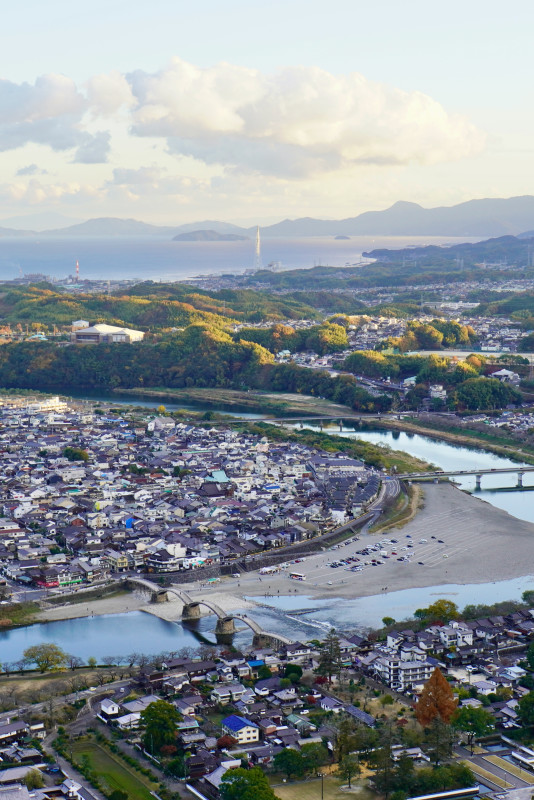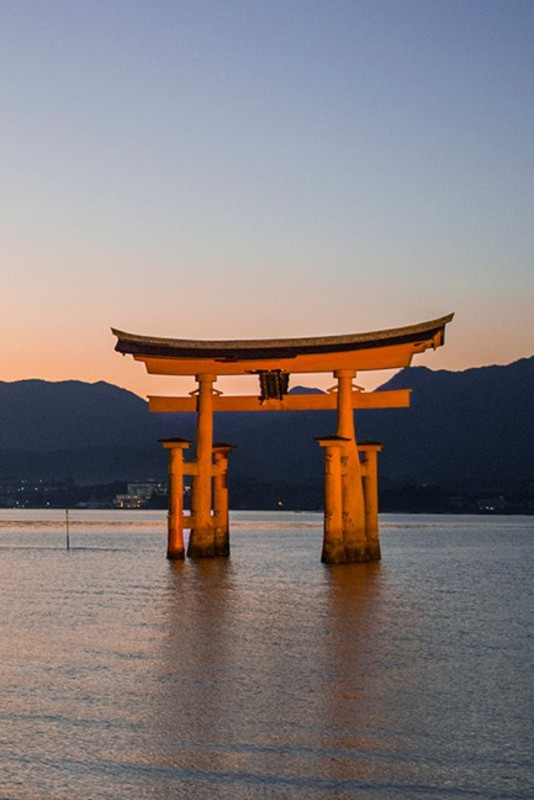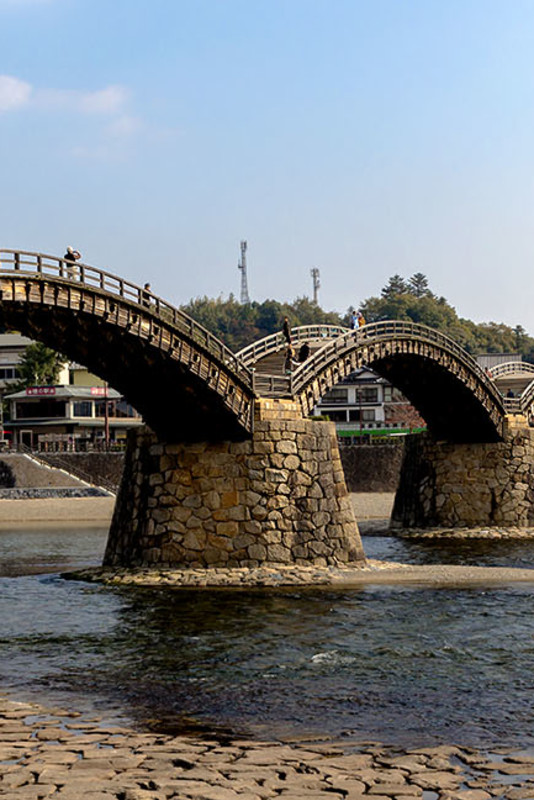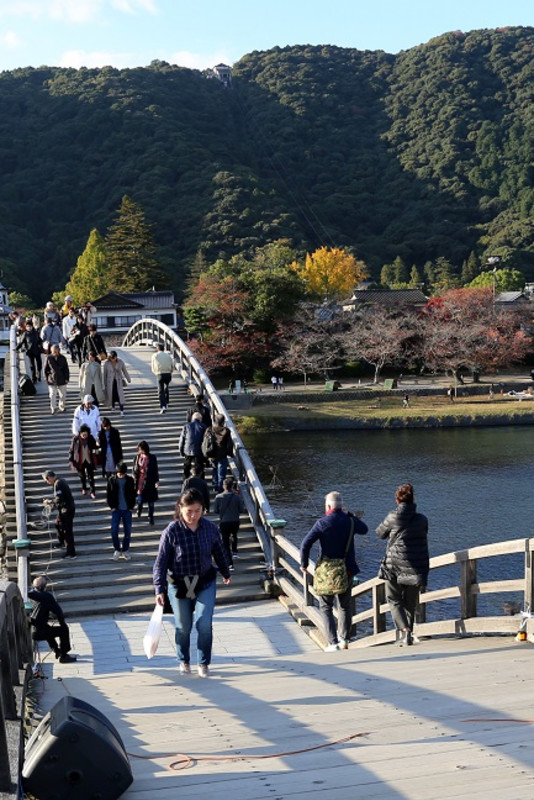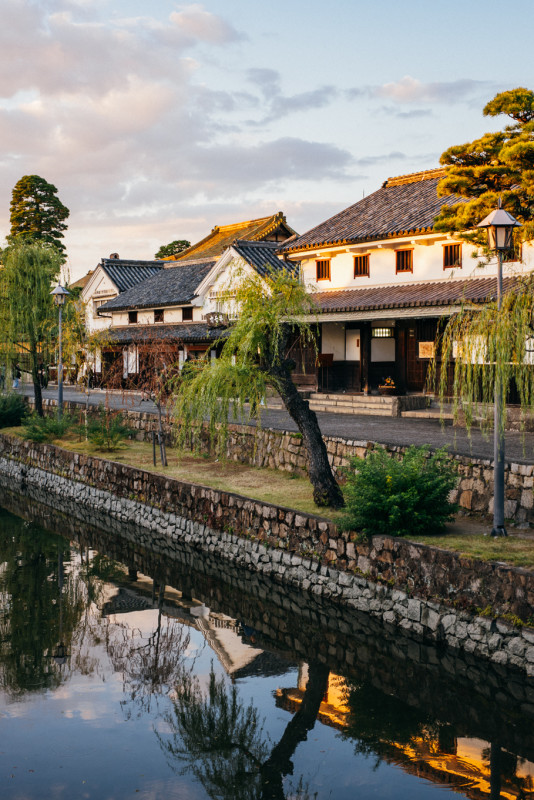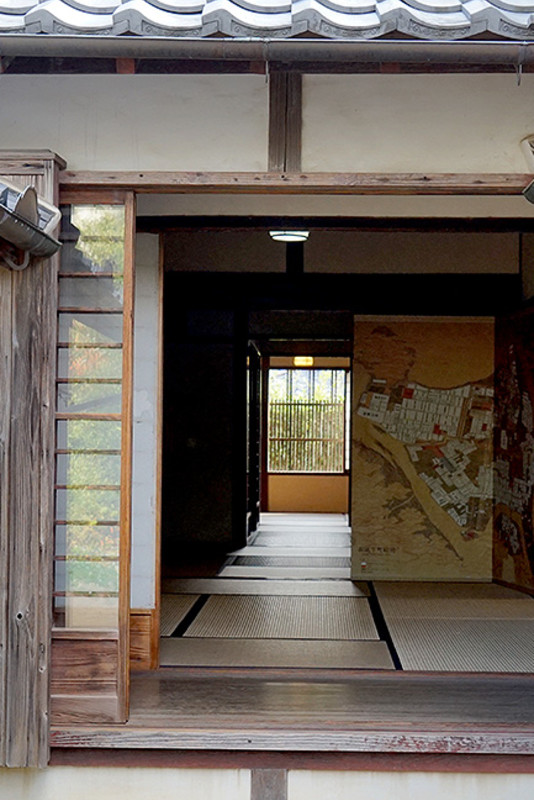Itineraries
Highlights of History and World Heritage in the Chugoku Region

Experience some of the best of Japan, including two World Heritage sites, in just 3 days. The Shinkansen bullet train whisks you from Osaka to Hiroshima by way of the picturesque port town of Onomichi. Explore the sacred island of Miyajima and view the illuminated Itsukushima Shrine World Heritage site, crowd-free, after dark. This trip ends with a visit to Iwakuni to see its stunning five-arched bridge and explore its samurai history along quiet streets.
- Day 1
- Onomichi and Hiroshima
Travel: Osaka to Onomichi
・Take the Shinkansen from Shin-Osaka Station to Fukuyama Station (Approx 1 hour 10 minutes)
・Take the local train from Fukuyama Station to Onomichi Station (Approx 20 minutes)
Mt Senkoji and Cat Alley
Onomichi is a port town with a history that stretches back to the middle ages. Streets so narrow they hardly deserve the name criss-cross the steep mountainside that rises from the waterfront are lined with tumble-down houses and there seem to be as many cats in residence as people. It is a delightful place to spend a few hours and a frequent cable car service takes some of the strain out of exploring the town.
Head down the town’s retro shopping arcade with its mix of decade’s old shops and stylish cafes to Mt. Senkoji Ropeway Station. Be sure to check out the impressive 900-year-old camphor trees in Ushitora Shrine before making the 3 minute trip up the mountain. After taking in the incredible views from Senkoji Temple, make your way back down to the waterfront via the appropriately-named Cat Alley, passing some of the temples that are part of Onomichi’s 2.5 km Temple Walk.
Onomichi Waterfront
Back at sea level, enjoy a coffee or refreshing local citrus drink on the boardwalk at Onomichi U2, a restored warehouse which now houses a cafe, bakery and restaurant, as well as souvenir shops and a hotel.
Onomichi Ramen
If you are in the mood for something more substantial, try Onomichi Ramen. With a soy sauce based soup made with locally caught fish and pork fat, it is, without doubt, Onomichi’s soul food. The local favorites are easily recognizable from the long lines out front.
Onomichi by mini-velo
An alternative to hiking Onomichi’s mountainside alleyways is exploring the waterfront area on high-end mini-velo bikes. Standard and battery assisted mini-velo bikes are available for rent from a number of places near Onomichi Station.
Travel: Onomichi to Hiroshima
・ Take a local train from Onomichi Station to Mihara or Fukuyama (Approx 15-20 minutes)
・ Take the Shinkansen from Mihara Station or Fukuyama Station to Hiroshima Station (Approx 20-30 minutes)
・ Alternatively, take a taxi to Shin-Onomichi Station (Approx 10 minutes) and take the Shinkansen from Shin-Onomichi Station to Hiroshima Station (Approx 40 minutes)
Learn about Hiroshima A-bombing and the city’s recovery
Today, Hiroshima, the site of the world’s first atomic bombing, is a vibrant city which looks to the future while remembering the terrible cost of war. Spend some time among the people of Hiroshima and one cannot help but marvel at the city’s resilience and remarkable recovery.
Visiting Hiroshima’s Peace Memorial Park, Peace Memorial Museum, and the World Heritage Site of the Atomic Bomb Dome memorial is the primary motivation for most who visit Hiroshima. It is a sobering and often emotional experience. If time allows, seek out a quiet spot among the trees to reflect on the experience before returning to the hustle and bustle of the city.
Sokoiko! Peace Cycle Tour
Starting from Peace Memorial Park, friendly local guides lead you around central Hiroshima, stopping at significant sites related to the A-bombing. Focusing on the city’s recovery as well as on the tragedy of the bombing, the Sokoiko! Peace Cycle Tour is a moving experience that is highly rated by visitors from around the world.
Hiroshima Castle and Shukkeien Garden
Although reconstructed after being almost completely destroyed in the A-bombing, the grounds of these two places closely connected to the early history of Hiroshima are very pleasant for a stroll. The castle houses an informative museum and the koi carp in the pond at Shukkeien Garden are always eager to be fed. Look out for several trees that miraculously survived the A-bombing in each location.
Hiroshima Okonomiyaki
There is no better place to experience how welcoming the people of Hiroshima are, than at the grill in a local okonomiyaki shop. It is no exaggeration that most of Hiroshima’s population was raised on this hearty layered pancake and watching it being prepared by a veteran chef is as entertaining as the finished dish is delicious. Vegan diners can also enjoy the full okonomiyaki experience at Nagataya and Jirokichi.
Bar hopping in Eki Nishi
To raise a glass with the locals after dark, head to Eki Nishi, a small area crammed with bars and eateries next to Hiroshima Station.
Accommodation: Hilton Hiroshima
A short taxi ride from Hiroshima Station and within walking distance of Hiroshima Peace Memorial Park, the Hilton Hiroshima is the perfect place to base yourself during a visit to Hiroshima. With well-appointed, modern rooms, and excellent guest facilities, the Hilton Hiroshima is a luxurious refuge in which to relax, recharge and ready yourself to explore the city or head to your next destination.
Four restaurants serve Japanese and international cuisine using locally sourced ingredients. In the Executive Lounge on the 22nd floor, guests can enjoy evening cocktails and light snacks, as well as a variety of beverages, while taking in the views over islands of the Seto Inland Sea and surrounding mountains.
A guest relations officer is also on hand to provide assistance with sightseeing and restaurant reservations. Take the relaxation up another level with a visit to the luxurious Spa by L’OCCITANE.
URL: Hilton Hiroshima
- Day 2
- Miyajima
Travel: Hiroshima to Miyajima
・Take the local train from Hiroshima Station to Miyajima-guchi Station (Approx 30 minutes)
・Take the ferry from Miyajima-guchi to Miyajima (Approx 10 minutes)
World Heritage Sea Route
High speed ferries make the journey between Hiroshima’s two UNESCO World Heritage Sites in approximately 45 minutes. Hiroshima departures are from Peace Memorial Park, just south of the A-bomb Dome Memorial. Please check the website as schedules change according to the tides.
URL: http://www.aqua-net-h.co.jp/en/heritage/
Itsukushima Shrine and Miyajima
A sacred site since time immemorial, originally built in its current form some 800 years ago, Itsukushima Shrine on the island of Miyajima is the second UNESCO World Heritage Site on this itinerary. The huge vermilion shrine gate which stands in the water is one of the most iconic sights in Japan. Be sure to check tide time on the day of your visit. The sight of Itsukushima Shrine and the “floating” shrine gate at high tide is one that will never be forgotten. Low tide offers the opportunity to walk out to see the towering shrine gate up close.
The area around the shrine is crowded with many ancillary temples and shrines which well-illustrate the long interconnected history of Buddhism and Shinto before separation was enforced in 1868. Overlooking Itsukushima Shrine is the impressively unfinished Senjyokaku 1000 Mat Pavilion and the Five-storied Pagoda which stands next to it. At the base of Mt. Misen, also part of the UNESCO World Heritage Site) is the fascinating Shingon Buddhist temple complex of Daisho-in.
Eat your way around Miyajima
Understandably, Miyajima attracts many visitors eager to snap a shot of one of Japan’s three most scenic views and there are many shops and restaurants to accommodate them. Local specialities such as plump grilled oysters, conger eel and maple leaf shaped Momiji-manju sweet bean cakes, in addition to a whole range of tasty street food, can be had along lively Omotesando, while a more relaxed vibe can be enjoyed on the quieter Machiya Street which runs parallel to Omotesando.
Kimono and culture workshops in a local temple
OKEIKO Japan offers opportunities to dress in authentic kimono and experience tea ceremony, calligraphy and even cooking, within the confines of a pretty temple.
The joy of Miyajima at dusk
It is possible to find corners of peace at even the busiest of times, but staying overnight on the island allows you to enjoy the serene tranquility of Miyajima once the day trippers leave. An evening stroll to view the great shrine gate, illuminated from dusk, is a wonderful way to end your day on this sacred isle.
Accommodation: Iwaso
A stay at Iwaso is a truly authentic ryokan experience. Originally established as a teahouse in 1854, it has become the go-to choice for dignitaries (Iwaso hosted the G7 leaders for dinner during the 2023 Hiroshima G7 Summit) and celebrities seeking a quiet retreat and old world charm while visiting Miyajima Island. Located at the entrance to Momijidani (Maple Valley), a short distance from both Itsukushima Shrine and the ropeway and hiking trails to Mt. Misen, Iwaso is the perfect place to stay to make the most of your time on the island. The service, discrete and efficient, is, as you would expect, top notch and the kaiseki meals, featuring local specialities such as oysters and conger eel are exceptional. As well as well-appointed tatami mat rooms, four private streamside cottages, each with its own unique history and design, are also available.
URL: http://www.iwaso.com/english/
- Day 3
- Iwakuni
Travel: Miyajima to Iwakuni, Kintaikyo Bridge
・Take the ferry from Miyajima Ferry Terminal to Miyajima-guchi Ferry Terminal (Approx 10 minutes).
・Take the local train from Miyajima-guchi Station to Iwakuni (Approx 20-40 minutes).
・Kintaikyo Bridge is approx 12 minutes by taxi or 30 minutes by local bus from Iwakuni Station.
Kintaikyo, one of the most beautiful bridges in Japan
After an early morning stroll, it is time to leave Miyajima behind and head to the site of another incredible example of traditional Japanese architecture and engineering, the five-arched Kintaikyo Bridge in Iwakuni.
The five elegant wooden arches span the 200-meter wide Nishiki River, supported by huge stone supports. Originally built in 1673, the bridge has suffered flood damage on several occasions. However, thanks to continual maintenance and reconstruction we can still enjoy this extraordinary bridge today. As well as walking across the bridge, be sure to appreciate the intricate, and beautiful, woodwork from beneath too.
The riverside here is particularly pretty during cherry blossom season, and, if your schedule allows you to linger until dusk, the bridge is illuminated most evenings of the year and displays of traditional cormorant fishing are conducted on summer evenings.
Kikko Park and Iwakuni Castle
Kintaikyo Bridge takes you into Kikko Park, which now occupies that area where the feudal lords of Iwakuni used to live. It is a lovely area to walk around, enjoying the preserved historical buildings and seasonal flowers which add color throughout the year. Tea ceremonies open to the public are held many Sundays of the year at Kikko Tea House and one of Iwakuni’s more unusual attractions are its white snakes which are venerated as a guardian deity of households. Near the White Snake Museum, you can also see some of the cormorants used in traditional cormorant fishing displays.
On the mountain overlooking Kikko Park is Iwakuni Castle. The history of the original castle was short-lived, destroyed in 1615 by order of the Shogun only seven years after it was built. Although the current keep is a reconstruction that only dates from 1962, accessible by ropeway, the high vantage point offers a fantastic view of the Kintaikyo Bridge and the river below.
Iwakuni Sushi, Sake and Samurai Dress Up
Local culinary specialties include pressed Iwakuni Sushi and lotus root (renkon). Hirase, which has a great view of Kintaikyo Bridge is known as the place for Iwakuni Sushi.
For something lighter, try a simple tasting menu which includes bite-sized samples of local delicacies, accompanied by locally brewed sake at Honke Matsugane visitor center housed in a restored 19th century merchant house which once sold hair oil to the samurai. By arrangement, you can also be dressed in faithful reproductions of samurai battle armor here for an enviable photo souvenir.
Before you leave Iwakuni
One of the most fun places to eat in this part of Japan is Irori Sanzoku. People drive from far and wide to experience the festival-like atmosphere of this ebullient imagining of a sprawling mountain bandit encampment. Signature dishes – Sanzoku grilled chicken, udon noodles and giant rice balls — may be simple, but they are very tasty and a meal at Sanzoku is always a memorable experience.
At Murashige Sake Brewery, a short walk from Shin-Iwakuni Shinkansen station, as well as marveling at the world’s biggest sugi-dama (the cedar balls that you see hanging in front of sake breweries and shops), you can enjoy sake tastings, try sweets made from sake and sake lees and pick up unique souvenirs.




































































